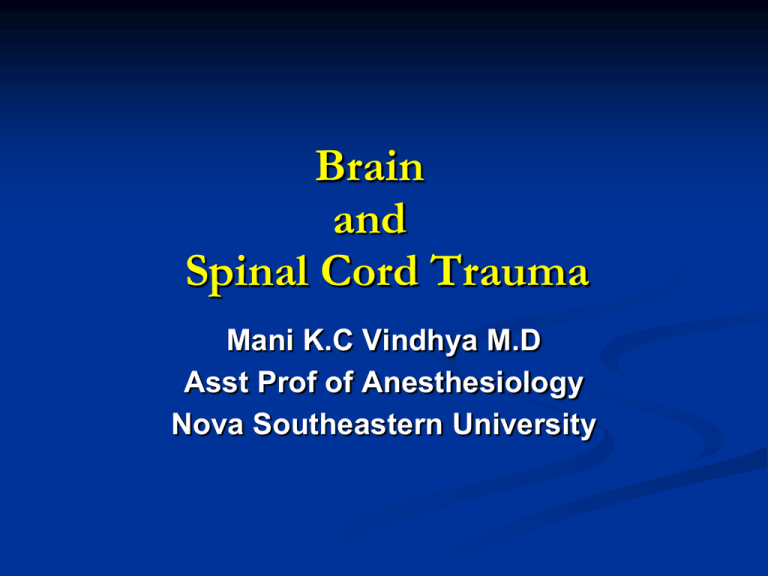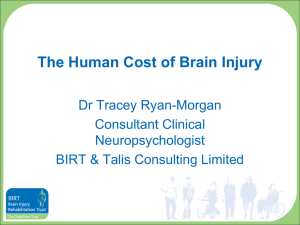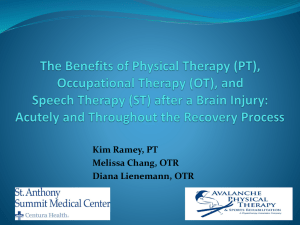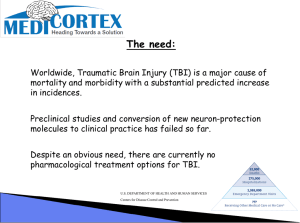Preoperative Thallium Scanning, Selective Coronary
advertisement

Brain and Spinal Cord Trauma Mani K.C Vindhya M.D Asst Prof of Anesthesiology Nova Southeastern University ABC’s of Anesthesia for Traumatic Brain Injury (TBI) Airway management Blood pressure management CO2 (Hyperventilate or not?) Diuretics or Dexamethasone? Early decompressive craniectomy Fluid management Glucose management Hypothermia (Is it “cool” or not?) IV and Inhaled Anesthetics Airway Management in TBI Issues in Intubating the Head-Injured Patient (JC Drummond, ASA Refresher Course Lecture 144: 1-7, 2000) Head Intracranial pressure (ICP), altered mental status, uncooperative/combative patient Neck Assume unstable C-spine Airway Blood, injury, skull base fracture Breathing Hypoxemia Circulation Assume hypovolemia Digestive Juices Assume full stomach Principles for Resuscitating the Head-Injured Patient First ABC, then ICP. 1. The ABC’s initially take priority over ICP (JC Drummond, ASA Refresher Course Lecture 144: 1-7, 2000). Secure the airway. Breathing: Guarantee gas exchange, oxygenation and ventilation. Stabilize the circulation Think associated injuries. 2. Unstable C-spine injury could lead to a cervical cord injury (Doolan LA,O’Brien JF. Anaesth Int Care 13: 319-24, 1985). If a rapid sequence induction and intubation, then... Cricoid pressure (Sellick maneuver) & Manual in-line stabilization Which patients need immediate intubation? Empirically, patients with a Glasgow Coma Scale (GCS) < 8 require intubation and controlled ventilation for airway and/or ICP control. Patients with a GCS of 9-12 require close observation. Some of these will “talk and die” Delayed deterioration observed up to 48 hours after initial injury (Marshall LF et al. J Neurosurg 59: 285-8, 1983). Glasgow Coma Scale (GCS) Eyes open Never To pain To speech Spontaneously 1 2 3 4 Best verbal responses None Garbled, incomprehensible sounds Inappropriate words Confused but converses Oriented 1 2 3 4 5 Best motor responses None Extension (decerebrate rigidity) Abnormal flexion (decorticate rigidity) Withdrawal Localizes pain Obeys commands 1 2 3 4 5 6 Total 3-15 C. Cervical Fractures are Common in Along with Traumatic Brain Injury 1. Cervical spine injury occurs in 2% of victims of blunt trauma (Crosby ET.Anesthesiology 104: 1293-1318, 2006.) 2. Higher incidence of cervical injury in patients who have experienced severe traumatic brain injury, as determined by: A. low Glasgow Coma Scale (GCS) and B. Unconsciousness Association between GCS and cervical spine injury (Demetriades D et al. J Trauma 48: 724-7, 2000). Injury Severity (GCS Score) % of Patients with C-Spine Injury 13-15 9-12 <8 1.4 % 6.8 % 10.2 % 4. Of those patients who need emergent intubation (GCS < 8), roughly10% (1 in 10) have an associated C-spine injury! 5. C-spine injuries may be missed by neck films or CT scans (Crosby ET, Lui A. Can J Anaesth 37: 707-9, 1990; Drummond JC, ASA Refresher Course Lecture144: 1-7, 2000). Lateral X-ray misses 20% of C-spine fractures. Lateral and AP and odontoid views miss only 7%. 7 to 14% of C-spine fractures involve C7 and/or T1. Intubating the Head-Injured Patient 1. If pentothal (or etomidate)-sux-tube... (Drummond JC, ASA Refresher Course Lecture 144: 1-7, 2000) a. Manual in-line stabilization (no pillow, head held rigid on backboard) Axial traction could lead to extension injury Cricoid pressure Back of collar in place Optimum exposure of vocal cords may be limited with in-line stabilization Not sniffing position Case report: “Neurologic Deterioration with Airway Management in a C-spine-injured Patient” (Hastings RH, Kelley SD. Anesthesiology 78: 580-3, 1993). MVA; neck pain; 3 views “normal” Delayed respiratory distress Succinylcholine, intubation Paraplegic CT: C6-C7 prevertebral hematoma Remember other intubation options (JC Drummond, ASA Refresher Course Lecture 144: 1-7, 2000): Fiberoptic oral / nasal Blind nasal (not if basilar skull fracture) Light wand / stylettes Augustine guide Glidescope, Bullard scope, etc. Retrograde cannulation LMA (as backup for failed intubation) Cricothyrotomy Case reports: “Beware of the basilar skull fracture!” a. “Complication from a naso-pharyngeal airway in a patient with a basilar skull fracture.” (Muzzi DA et al. Anesthesiology 74: 366-8,1991) b. “Intracranial placement of a nasotracheal tube after facial fracture: a rare complication” (Marlow TJ, Goltra DD Jr, Schabel SI. J Emerg Med 15: 187-91, 1997) Blood Pressure (BP) Management in TBI Three historical strategies to manage MAP after TBI. The strategy depends on the relationship of cerebral blood flow (CBF) to MAP after head injury (Drummond JC, Patel PM. “Neurosurgical Anesthesia,” Chap. 53 in Miller RD ed., Miller’s Anesthesia, 6th ed., Churchill Livingstone, Philadelphia, 2005: pp. 2127-73.) Approach Assumption About Autoregulation Assumption About MAP “Lund” Approach Abolished (steep rise) Avoid hyperemia, keep MAP down “Edinburgh” Approach Abolished (gradual rise) Avoid decreased CBF, keep MAP up “Birmingham” Approach Intact (but plateau lower) Avoid decreased CBF, keep MAP up A new and evolving theme in neurosurgical management of TBI (JC Drummond, ASA Refresher Course Lecture 144: 1-7, 2000) 1. We used to worry about cerebral hyperemia (too much CBF), and tended to decrease BP. 2. Now we worry about cerebral ischemia (not enough CBF), and tend to increase BP. Hypoperfusion is very common after TBI (on the first day) Autoregulation is impaired. Brain is very vulnerable to secondary injury. Hypotension after TBI is associated with particularly “bad” outcomes. Impact of Hypoxia and/or Hypotension on Outcome after Closed Head Injury (GCS < 8) [at time of hospital arrival] (Chesnut RM et al. J Trauma 34: 216-22, 1993) Number % Good or Moderate % Poor or Dead Total 699 43% 57% Normotension/normoxia 456 51% 49% Hypotension (SBP<90) 113 24% 76% Hypoxia (paO2 < 60) 78 45% 55% Hypoxia and hypotension 52 6% 94% “Deleterious effects of intraoperative hypotension on outcome in patients with severe head injuries” (Pietropaoli JA et al, J Trauma 33: 403-7, 1992) 53 blunt head injuries All required surgery. Problems surgeons reading anesthesia records retrospective methodology If SBP > 90 mm Hg intraoperatively, mortality = 25% If SBP < 90 mm Hg intraoperatively, mortality = 82% (P < 0.001) Brain Trauma Foundation: Recommendations to Manage Severe TBI (Joint Section on Neurotrauma and Critical Care, The Brain Trauma Foundation, Surgeons AAoN: Guidelines for the Management of Severe Head Injury. Park Ridge, IL, The American Association of Neurological Surgeons, 1995.) Standards, Guidelines, and Options Standards – represent principles that reflect a high degree of clinical certainty Guidelines – reflect a moderate degree of clinical certainty Options – represent principles for which there is unclear clinical certainty Resuscitation of BP and Oxygenation Standard – none Guideline – Hypotension (SBP < 90 mm Hg) or hypoxia (apnea or cyanosis in the field or a paO2 < 60 mm Hg) must be scrupulously avoided, if possible, orcorrected immediately Option – MAP should be maintained above 90 mm Hg throughoutthe patient’s course BP Management in TBI: What’s the Bottom Line for Us? 1. Avoid hypotension (SBP < 90 mm Hg) if possible, or correct itimmediately 2. MAP > 70-80 mm Hg is reasonable CO2 Management in TBI Should we hyperventilate? Concepts in TBI have totally changed Hyperventilation and hypocapnia (paCO2 of 25): Decreases ICP But also decreases CBF, predisposing to cerebral ischemia Some studies showing that hyperventilation may be deleterious in TBI: “Does acute hyperventilation provoke cerebral oligaemia in comatose patients after acute head injury?” (Cold GE. Acta Neurochir 96: 100-6, 1989) 27 comatose head injury patients Intra-carotid 133Xe to measure CBF paCO2: From 35 to 25 CBF < 20: Foci went from 9/27 to 15/27 CBF < 15: Foci went from 2/27 to 9/27 “Effect of hyperventilation on regional cerebral blood flow in head- injured children” (Shippen P et al. Crit Care Med 25: 1402-9, 1997) 23 children; isolated TBI; GCS from 3 to 7 paCO2 > 35, 2535, and < 25 mm Hg Baseline CBF (Xe CT) slightly decreased CMRO2 1/3rd of normal % ischemic: Normocapnia (28.9%) vs. hypocapnia (73.1%) Moderate hyperventilation induced a harmful reduction in brain tissue PO2 (Imberti R et al. J Neurosurg 96: 97-102, 2002). Brain Trauma Foundation: Recommendations Regarding Hyperventilation Standard: (One of the few) In the absence of increased ICP, chronic prolonged hyperventilation therapy (paCO2 < 25 mm Hg) should be avoided after severeTBI Guideline: The use of prophylactic hyperventilation therapy (paCO2 < 35 Hg) during the 1st 24 hours after severe TBI should be avoided because it can compromise cerebral perfusion during a time when CBF is decreased. Option: Hyperventilation therapy may be necessary for brief periods when there is acute neurologic deterioration, or for longer periods of time if there is intracranial HTN refractory to sedation, paralysis, CSF drainage, and osmotic diuretics. Hyperventilation in TBI: What’s the Bottom Line for Us? Don’t routinely hyperventilate the TBI patient intraoperatively. A paCO2 of 35 mm Hg is reasonable. Hyperventilate to paCO2 of 25 only if needed (i.e., “swollen brain”). Diuretics or Dexamethasone in TBI? Diuretics in TBI? The osmotic diuretic mannitol is often employed in the setting of TBI. Mannitol requires an intact blood:brain barrier to work The blood:brain barrier is probably not intact in areas of severe TBI. But we use mannitol anyway, hoping it will “shrink” normal brain. Dexamethsone in RBI? Corticosteroids are thought to be beneficial to shrink edema around solid brain tumors. They are not beneficial, and may even be harmful, in TBI (Dearden NM et al. J Neurosurg 64: 81-8, 1986; Alderson P, Roberts I. BMJ 314: 1855-9, 1997; Yates RI et al, Lancet 364 (9442): 1321-8, 2004). Bottom Line? Don’t use steroids in TBI! (But do use high-dose Solumedrol [methylprednisolone] for acute spinal cord injury!) Early Decompressive Craniectomy Early decompressive craniectomy for intractable intracranial hypertension is “what’s new” in TBI. 2006 Study: “better-than-expected functional outcome in patients with medically uncontrollable ICP and/or brain herniation, compared with outcomes in other control cohorts...” (Aarabi B et al. J Neurosurg 104: 469:79, 2006). “...insufficient data to support the routine use of DC [decompressive craniectomy] in TBI” (Schirmer CM et al. Neurocritical Care 8: 456-70, 2008). Bottom line for us? More “midnight specials” while on call? Fluid Management in TBI Basic principles of fluid management in TBI The mantra in intracranial neuro used to be “Run ‘em dry.” Now the mantra is “Run ‘em even.” Avoid hypovolemia with fluid replacement. For normal craniotomy, Deficit + Hourly maintenance + Cover urine cc for cc Cover blood loss 3:1 with crystalloid A negative fluid balance is associated with a bad outcome. In humans, exceeding certain thresholds was associated with an increased percentage of patients with poor outcome (Clifton GL et al. Fluid thresholds and outcome from severe brain injury. CritCare Med 30: 739-45, 2002): Fluid balance < -594 ml Mean arterial pressure < 70 mm Hg Intracranial pressure > 25 mm Hg Which fluid is best in TBI? Usually normal saline is recommended as the crystalloid for resuscitation. NSS is slightly hypertonic. Lactated Ringer’s Is slightly hypotonic + Lactate converted to glucose in liver Give blood or colloid as needed. In an experimental model of TBI, brain water content was increased with both ½ NSS and NSS, relative to blood or colloid (Drummond JC et al. Anesthesiology 88:993-1002, 1998). Glucose Management in TBI Hyperglycemia is detrimental. Elevated glucose levels are deleterious in cerebral ischemia. In animal models, hyperglycemia at onset of ischemia worsens outcome In humans, hyperglycemia is associated with a worsening of post-ischemic brain injury Why? Intracellular acidosis probably injures neurons and glia (Wass CT, Lanier WL. Mayo Clin Proc 71: 801-12, 1996) Glucose Management in TBI: What’s the Bottom Line? Monitor glucose levels to maintain “normoglycemia” as rigidly as possible. Avoid IV glucose infusions unless necessary (NB: drug infusions) Use insulin to treat hyperglycemia. Don’t allow a sustained glucose > 250. Avoid hypoglycemia and electrolyte abnormalities. Hypothermia in TBI was hot, but now it’s not! National Acute Brain Injury Study: Hypothermia (NABIS:H) = prospective, multicenter, randomized trial (Clifton GL et al. N Engl J Med 344: 556-63, 2001) “Treatment with hypothermia, with the body temperature reaching 33 oC within 8 hours after injury, was not effective in improving outcomes in patients with severe brain injury.” Patients that were hypothermic on admission and warmed did poorly. Patients that were hypothermic on admission and stayed hypothermic seemed to do better. So don’t rewarm hypothermic patients too quickly. Bottom line? Mild induced hypothermia Not beneficial: After traumatic brain injury During clipping of intracranial aneurysms (Todd MM et al, New Engl J Med 352: 135-45, 2005. Beneficial after successful resuscitation from cardiac arrest (New ACLS Guidelines) Avoid hyperthermia. Inhaled Anesthetics Reasonable maintenance regimens for intracranial neuroanesthesia (going from routine to desperate) N2O + isoflurane (1/2%) + fentanyl? N2O = the first agent to go if there’s brain swelling or venous air emboli or danger of ischemia (i.e., head trauma) MAC equivalents of sevoflurane or desflurane might also be substituted for isoflurane Sufentanil could be substituted for fentanyl. Isoflurane (1%) + fentanyl Isoflurane (1/2%) + propofol + fentanyl The volatile agents are next to go if the brain is compromised (i.e. markedly increased ICP or brain swelling). Total IV anesthetic: propofol + fentanyl Barbiturate coma – for intractable brain swelling (titrated to EEG burst suppression) Thiopental Pentobarbital? ICP Monitoring in TBI Brain Trauma Foundation Guideline. ICP monitoring is appropriate in severe head injury patients (GCS < 8) with an abnormal CT, or a normal CT scan if 2 or more are noted on admission: Systolic BP < 90 mm Hg Age > 40 years Uni- or bilateral motor posturing What patients need ICP monitoring during nonneurologic surgery? (JC Drummond, ASA Refresher Course Lecture 144: 1-7, 2000) Level of consciousness? If loss of consciousness at any time or GCS < 15, have neurosurgery check CT scan. ICP monitoring is advisable if compressed basal cisterns, midline shift, effaced ventricles, or any intracranial lesion (i.e. contusion, small subdural). Time since injury. Delayed deterioration has been observed up to 48 hourspost-injury Intended aortic occlusion, i.e. repair of ruptured aorta Nature and duration of intended procedure (i.e. short debridement vs. long orthopedic procedure) Summary: ABC’s of Anesthesia for Traumatic Brain Injury Airway. Safely get control. Blood pressure Choose an anesthetic that maintains MAP. Avoid hypotension (SBP < 90 mm Hg) if possible, correct it immediately. MAP > 70-80 mm Hg is reasonable. Carbon dioxide. Don’t routinely hyperventilate, only if necessary for a “swollen brain.” Diuretics or Dexamethasone? We usually give diuretics (mannitol). We usually don’t give steroids. Early decompressive craniectomy may cause us many sleepless nights. Fluids. Avoid hypovolemia. Glucose. Treat hyperglycemia. Hypothermia was “hot”, but now it’s not. Avoid hyperthermia. IV and Inhaled Anesthetics. N2O is first to go. Volatile inhaled anesthetics are next to go. TIVA (with fentanyl and propofol) is reasonable Thiopental (for EEG burst suppression) if intractable brain swelling Acute and chronic spinal cord injury (SCI) Effects of spinal cord lesions ( Ezekiel MR. Handbook of Anesthesiology,2002-2003 Edition. Current Clinical Strategies Publishing, pp. 165-66): LESION SITE COMMON PROBLEM C3-C5 (Phrenic nerve) Usually apnea requiring intubation and mechanical ventilation Below C5-C6 Impaired oxygenation and ventilation (up to 70% decrease in VC and FEV1) T1-T4 (origin of cardio-accelerator fibers) Bradycardia, bradydysrhythmias, AV block, cardiac arrest Above T7 Significant alveolar ventilation impairment Issues in spinal cord injury (SCI): 1. Intubation options: Airway management of acute C-spine injury (JC Drummond, ASA Refresher Course Lecture 144: 1-7, 2000) Rapid sequence induction and intubation with in-line cervical fixation Fiberoptic oral / nasal intubation Blind nasal intubation (not if basilar skull fracture) Light wand/stylettes Glidescope, Bullard scope, etc. Retrograde cannulation Laryngeal mask airway (backup for failed intubation) Cricothyrotomy Succinylcholine Safe for use in first 24-48 hours Contraindications to succinylcholine: AFTER 24-48 HOURS AT ANY TIME Quadri- or paraplegia Hemiplegia (i.e., stroke) rd Extensive 3 degree burns Multiple trauma Chronic renal failure (K+ > 5.5) History of malignant hyperthermia (MH) Muscular dystrophy (such as Duchenne’s) Routine use in pediatrics 3. High-dose methylprednisolone (Bracken MB et al, N Engl J Med 322:1405-11, 1990) May improve functional recovery if given within 8 hours after SCI Loading dose = 30 mg/kg IV Maintenance dose = 5.4 mg/kg/hr IV for 23 hours Spinal shock Spinal shock (Ezekiel MR. Handbook of Anesthesiology, 2002-2003 Edition. Current Clinical Strategies Publishing, pp. 165-66) Seen in high SCI’s Lasts a few hours to several weeks Characterized by (below lesion): Loss of sympathetic tone Flaccid paralysis Total absence of visceral and somatic sensation Paralytic ileus Loss of spinal cord reflexes Autonomic hyperreflexia Autonomic hyperreflexia (Stoelting RK, Miller RD. Basics of Anesthesia, 4th ed. Churchill-Livingstone: 2000, pp. 328-9) A complication of chronic spinal cord transection (especially above T6) Sudden hypertension + reflex bradycardia Distension of hollow viscus (e.g. bladder) common precipitating event Prevented by spinal anesthesia (also by epidural or general anesthesia and anti-hypertensives such as nitroprusside Diagnosis may compel you to insert arterial line Basic Principles of SCI Difficult airway can be problematic. Unstable cervical spine. Don’t break the patient’s neck! Can’t use succinylcholine after 24-48 hours. Don’t cause a hyperkalemic code! Hemodynamic instability is common with anesthesia and surgery. Acute SCI: spinal shock and hypotension Chronic SCI: autonomic hyperreflexia and hypertension End of NeuroAnesthesiology









